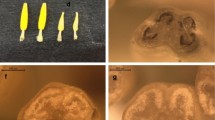Summary
Cytoplasmic male sterility (cms) and nuclear male sterility (nms) in Petunia were described respectively as possible “autonomous” and “integrated” states of the same genetic element by Frankel (1971). In the present study we describe genetic analysis of the interaction between the cms, the nuclear gene for male sterility (e) and the fertility restorer allele (Rf). The main findings in this study are: (1) The nuclear sterility allele can coexist in one or two dosages with the cytoplasmic male sterility elements (ste) in somatic cells or female gametes; (2) the presence of the fertility restorer allele Rf is not required for the coexistence of ste and e and (3) Rf does not interact epistatically with e, e.g., the expression of e is independent of Rf—the genotypes (S) RfRfee and (S) Rfrfee are male sterile.
Similar content being viewed by others
References
Belliard G, Vedel F, Pelletier G (1979) Mitochondrial recombination in cytoplasmic hybrids of Nicotiana tabacum by protoplast fusion. Nature 281:401–403
Bianchi F (1963) Transmission of male sterility in petunia by grafting. Genen Phaenen 8:36–43
Boeshore M, Lifshitz I, Hanson M, Izhar S (1983) Novel composition of mitochondrial genomes in Petunia somatic hybrids derived from cytoplasmic male sterile and fertile plants. Mol Gen Genet 190:459–467
Boeshore M, Hanson MR, Lifshitz I, Izhar S Cytoplasmic male sterility-associated mitochondrial DNA fragments in male sterile lines and somatic hybrids of petunia (in prepration)
Curtis GJ (1967) Graft-transmission of male sterility in sugarbeet (Beta vulgaris L.) Euphytica 16:419–424
Dixon KL, Leaver CJ (1982) Mitochondrial gene expression and cytoplasmic male sterility in sorghum. Plant Molec Biol 1:89–102
Edwardson JR, Corbett MK (1961) Asexual transmission of cytoplasmic male sterility. Proc Natl Acad Sci USA 47:390–396
Edwardson JR, Warmke HE (1967) Fertility restoration in cytoplasmic male-sterile Petunia. J Hered 58:195–196
Evenor D, Guri A, Izhar S (1984) The relationship between a nuclear restorer gene and a nuclear gene which induces male sterility in petunia. Theor Appl Genet (in press)
Evenor D (1984) Ph. D. Thesis. Hebrew University, Jerusalem
Forde BG, Oliver RJC, Leaver CJ (1980) Classification of normal and male sterile cytoplasm in maize. I. Electrophoretic analysis of variation in mitochondrially synthesized proteins. Genetics 95:443–450
Frankel R (1956) Graft induced transmission to progeny of cytoplasmic male sterility in Petunia. Science 124:684–685
Frankel R (1962) Further evidence on graft induced transmission to progeny of cytoplasmic male sterility in Petunia. Genetics 4:641–646
Frankel R (1971) Genetic evidence on alternativ maternal and mendelian hereditary elements in petunia hybrida. Heredity 26:107–119
Galun E, Arzee-Gonen P, Fluhr R, Edelman M, Aviv D (1982) Cytoplasmic hybridization in Nicotiana: Mitochondrial DNA analysis in progenies resulting from fusion between protoplasts having different organelle constitutions. Mol Gen Genet 186:50–56
Gottschalk W, Kaul NLH (1974) The genetic control of microsporogenesis in higher plants. The Nucleus 17:133–156
Izhar S (1977) Cytoplasmic male sterility in Petunia, the interaction between the plasmagene, genetic factors, and temperature. J Hered 68:238–240
Izhar S (1978) Cytoplasmic male sterility in Petunia. III. Genetic control of microsporogenesis and male fertility restoration. J Hered 69:22–26
Izhar S (1984) Male sterility in Petunia. In: Sink KC (ed) The genus Petunia. Springer Verlag, Berlin Heidelberg New York (in press)
Izhar S, Frankel R (1971) Mechanism of male sterility in Petunia: The relationship between pH, callase activity in the anthers and the breakdown of microsporogenesis. Theor Appl Genet 41:104–108
Izhar S, Frankel R (1973) Mechanism of male sterility in Petunia: II. Free amino acids in male fertile and male sterile anthers during microsporogenesis. Theor Appl Genet 43:13–17
Izhar S, Frankel R (1976) Cytoplasmic male sterility in Petuna: 1. Comparative Study of different plasmatype sources. J Hered 67:43–46
Izhar S, Schlicter M, Swartzberg D (1983) Sorting out of cytoplasmic elements in somatic hybrids of Petunia and the prevalence of the heteroplasmon through several meiotic cycles. Mol Gen Genet 190:468–476
Jones DF (1956) Genic and cytoplasmic control of pollen abortion in maize. Brookhave Symp Biol 9:101–112
Laughnan JR, Gabay SJ (1975) An episomal basis for instability of S male sterility in maize and some implications for plant breeding. In: Birkey CV, Perlman PS, Byers TT (eds) Genetic and biogenesis of mitochondria and chloroplasts. Ohio State University Press, Columbus, Ohio, pp 330–342
Mans RJ (1982) Episomal DNA as molecular probe of cytoplasmic male sterility in S Zea mays. In: Sheridan WF (ed) Maize for biological research. PMBA Special Publication, Charlottesville Va., pp 263–266
Pring DR, Levings III CS, Hu WWL, Timothy DH (1977) Unique DNA associated with mitochondrial in the “S”-type cytoplasm of male sterile maize. Proc Natl Acad Sci USA 74:2904–2908
Pring DR, Levings III CS, Conde MF (1979) The organelle genomes of cytoplasmic male sterile maize and sorghum. In: Davies DR, Hopwood DA (eds) The plant genome. The John Innes Charity, Norwich, England, pp 111–120
Pring DR, Conde MF, Levings III CS (1980) DNA heterogeneity within the C group of maize male-sterile cytoplasm. Crop Sci 20:159–162
Thompson TE, Axtell JD (1978) Graft-induced transmission of cytoplasmic and male sterility. J Hered 69:159–165
Author information
Authors and Affiliations
Additional information
Communicated by G. Melchers
Contribution from the Agricultural Research Organization. The Volcani Center, Bet Dagan, Israel. 1983 series No. 846 E
Rights and permissions
About this article
Cite this article
Evenor, D., Izhar, S. Coexistence of cytoplasmic and nuclear genes for male sterility in Petunia . Molec. Gen. Genet. 194, 523–527 (1984). https://doi.org/10.1007/BF00425569
Received:
Issue Date:
DOI: https://doi.org/10.1007/BF00425569




